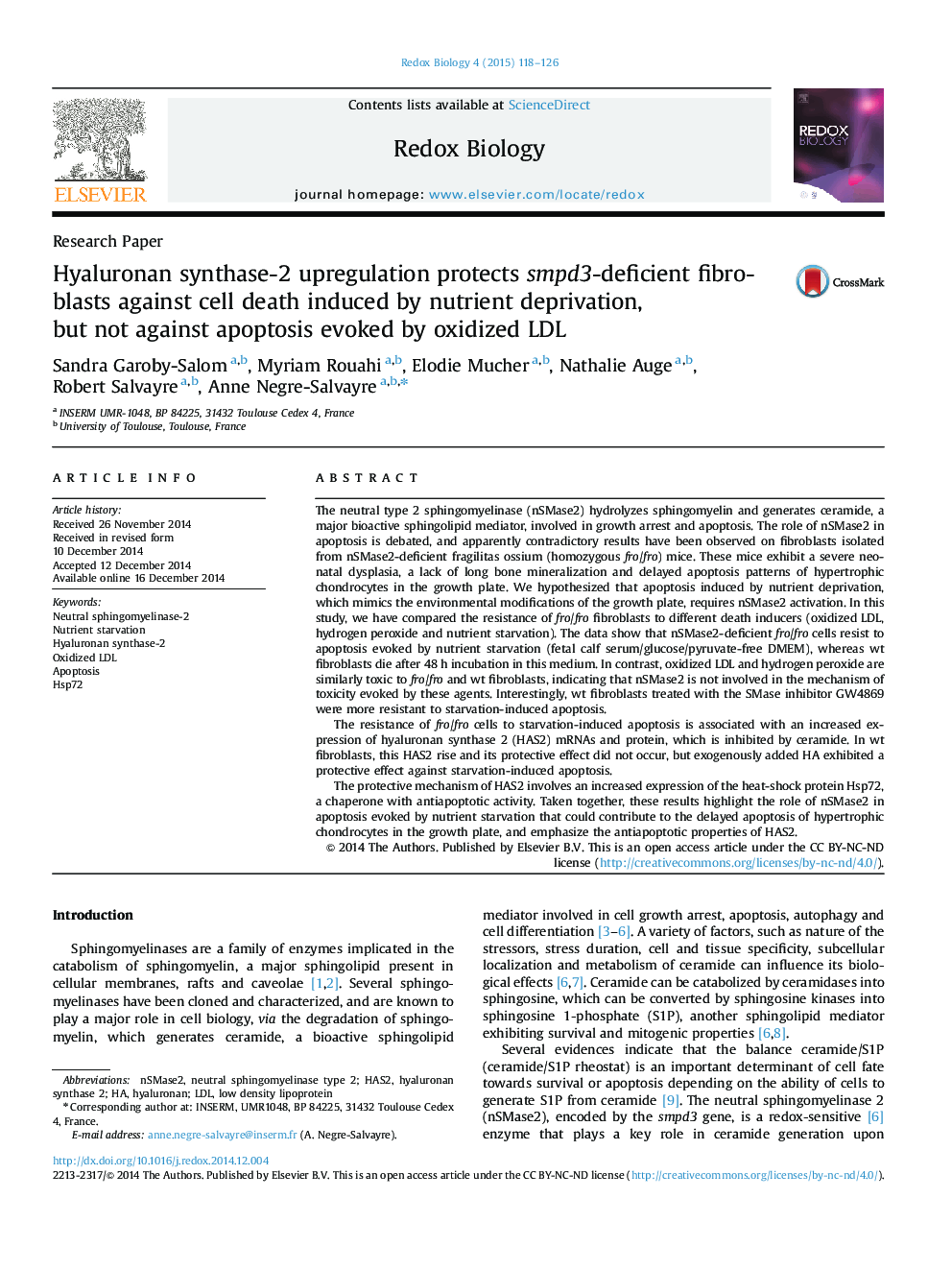| کد مقاله | کد نشریه | سال انتشار | مقاله انگلیسی | نسخه تمام متن |
|---|---|---|---|---|
| 1923087 | 1535846 | 2015 | 9 صفحه PDF | دانلود رایگان |

• Apoptosis evoked by oxidized LDL and H2O2 is comparable in fro/fro and wt fibroblasts.
• fro/fro fibroblasts resist to apoptosis evoked by nutrient starvation.
• HAS2 increased expression protects fro/fro fibroblasts against apoptosis.
• HAS2 regulates the expression of the antiapoptotic heat-shock protein HsP72.
The neutral type 2 sphingomyelinase (nSMase2) hydrolyzes sphingomyelin and generates ceramide, a major bioactive sphingolipid mediator, involved in growth arrest and apoptosis. The role of nSMase2 in apoptosis is debated, and apparently contradictory results have been observed on fibroblasts isolated from nSMase2-deficient fragilitas ossium (homozygous fro/fro) mice. These mice exhibit a severe neonatal dysplasia, a lack of long bone mineralization and delayed apoptosis patterns of hypertrophic chondrocytes in the growth plate. We hypothesized that apoptosis induced by nutrient deprivation, which mimics the environmental modifications of the growth plate, requires nSMase2 activation. In this study, we have compared the resistance of fro/fro fibroblasts to different death inducers (oxidized LDL, hydrogen peroxide and nutrient starvation). The data show that nSMase2-deficient fro/fro cells resist to apoptosis evoked by nutrient starvation (fetal calf serum/glucose/pyruvate-free DMEM), whereas wt fibroblasts die after 48 h incubation in this medium. In contrast, oxidized LDL and hydrogen peroxide are similarly toxic to fro/fro and wt fibroblasts, indicating that nSMase2 is not involved in the mechanism of toxicity evoked by these agents. Interestingly, wt fibroblasts treated with the SMase inhibitor GW4869 were more resistant to starvation-induced apoptosis.The resistance of fro/fro cells to starvation-induced apoptosis is associated with an increased expression of hyaluronan synthase 2 (HAS2) mRNAs and protein, which is inhibited by ceramide. In wt fibroblasts, this HAS2 rise and its protective effect did not occur, but exogenously added HA exhibited a protective effect against starvation-induced apoptosis.The protective mechanism of HAS2 involves an increased expression of the heat-shock protein Hsp72, a chaperone with antiapoptotic activity. Taken together, these results highlight the role of nSMase2 in apoptosis evoked by nutrient starvation that could contribute to the delayed apoptosis of hypertrophic chondrocytes in the growth plate, and emphasize the antiapoptotic properties of HAS2.
Nutrient starvation triggers apoptosis in wt fibroblasts, but not in fro/fro fibroblasts (in which nSMase2 is inactive). The resistance to nutrient deprivation-induced cell death in fro/fro cells is mediated by an increased expression of HAS2 and HA secretion and from the subsequent expression of the heat-shock protein Hsp72 that acts as a chaperone and anti-apoptotic protein. HAS2 is not protective against apoptosis evoked by oxLDL and H2O2, and fro/fro fibroblasts are not resistant to these agents.Figure optionsDownload as PowerPoint slide
Journal: Redox Biology - Volume 4, April 2015, Pages 118–126